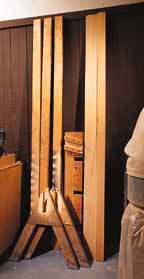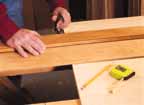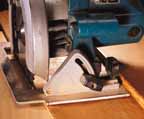We may receive a commission when you use our affiliate links. However, this does not impact our recommendations.
Precision cutting with a hand-held circular saw.
by Nick Engler

The cutting grid breaks down when you’re not using it and stores against a wall, along with the circular saw guide. The grid is so useful however, that mine is set up more often than not.
I’d like to know who it was that decided that plywood was best sold in 4-foot by 8-foot sheets. I’ve always thought that it was a practical joke in questionable taste to take such a wonderfully useful woodworking material and manufacture it in sheets that are bigger than most woodworkers.
More to the point, sheet materials are larger than the capacity of most woodworking machines. You can’t cut them safely on a garden-variety table saw without first chopping them into smaller pieces. Consequently, making precise cuts in sheet goods is a two-step
process for most woodworkers. First you cut the sheets into manageable sizes with a circular saw, then you trim the pieces to precise dimensions on a table saw. You can buy a panel saw or a sliding table for high-end table saws, but these are expensive pieces of equipment. And even if you can afford them, do you have space to use them? A panel saw, for example, takes up an enormous amount of wall space that most of us don’t have. I would much rather preserve the walls of my workshop as God intended – hung floor to ceiling with unfinished projects.
Making a Circular Saw Guide
Fortunately, there is an inexpensive, space-saving and ridiculously simple solution to this problem. You can make precision cuts in plywood and other sheet materials with an ordinary circular saw using a jig that that relies on the straightness of the outside edges that come with every piece of plywood.
The outside edges of a sheet of plywood as it comes from the manufacturer are commonly called factory edges. They are too rough to use in assembly, but they are usually dead straight. Consequently when you buck up a sheet of plywood to trim on a table saw, it’s a good idea to make sure each piece has a factory edge. Most craftsmen begin trimming operations by guiding this factory edge along the table saw rip fence – this creates another straight edge.
Instead of using the factory edge as a guide to trim the plywood on a table saw, I skip the trimming altogether and use a factory edge to guide a circular saw. To do this, you must make a circular saw guide.

After measuring the plywood and marking the beginning and end of the cut, align the base of the saw guide with the marks. The saw guide should be on the “save” side of the cutting path, and the tommy bars of the clamps must point down. If the bars stick up, they may interfere with the circular saw.
Select a sheet of cabinet-grade 1/2″ or 3/4″ hardwood plywood. With a circular saw, trim a 3″-wide strip from one of the 8′-long edges – this is the guide. To make the base, trim another strip 8-1/2″ wide from a sheet of 1/4″ plywood. Glue the guide and the base together with the sawed edge (not the factory edge) of the guide aligned with one of the edges of the base. Tip: The 3″-wide guide is narrow enough to bend, so check the assembly as you glue the parts together. Sight along the factory edge (or better yet, stretch a string along it) to make sure the guide remains straight.
When the glue dries, clamp the saw guide to a long board. Mount a high-quality carbide-tipped combination blade on your circular saw. This is important! For you to make precision cuts with any saw, you need a precision blade. Place the shoe of the saw on the base with the edge against the guide. The saw motor should overhang the guide. Trim the base so the distance from the guiding edge to the base edge is exactly the same as the distance from the edge of the shoe to the saw blade. This makes it a cinch to set up for a cut, as you’ll see in a minute.
Making a Cutting Grid
Before you get to the cutting, however, I suggest you make one more jig – a cutting grid to properly support the plywood while you’re laying out the parts and sawing them. My “grid” consists of two knock-down sawhorses. The horizontal beams of these sawhorses are notched to hold ordinary 8′-long 2 x 4s. When set up, the top edges of the beams are flush with the top edges of the 2 x 4s. This arrangement supports a sheet of plywood of any size edge-to-edge and end-to-end to keep it from sagging.

Make the cut with the circular saw motor hanging over the guide – this arrangement provides the most support for the saw and keeps it from tipping.
This grid is one of those truly indispensable jigs. Once I made one, I couldn’t imagine how I did without it. Not only is it useful for sawing, it also makes a great assembly table for large projects. On occasion, I’ve used it as a clamping grid for odd-shaped assemblies. And I always seem to employ it as a drying rack when I’m finishing a project. Even though I made the cutting grid to break down, it spends most of its time set up.
Making a Cut
Place the plywood on the cutting grid. If it’s a small piece, rest it over a sawhorse beam and a stringer so it’s supported in both directions. Measure the plywood and make two marks to indicate the beginning and end of the cut. If you were to draw a line through these marks, there is a “save” side of the line (the piece you’re going to save) and a “waste” side. Place the saw guide on the plywood over the “save” side and align the trimmed edge of the base with the marks. Clamp the guide to the plywood with two small (2″) C-clamps.
Adjust the depth of cut of the circular saw so the blade protrudes just 1/16″ to 1/8″ below the underside of the plywood as you make the cut.
The saw will bite into the top surfaces of the cutting grid; this can’t be avoided. But it won’t weaken the supporting structure as long as the cuts are shallow. Tip: When cutting across the surface grain of a sheet of plywood, you can prevent the veneer from splintering or “feathering” by scoring along the edge of the base with a utility knife before you make the cut.
Just how accurate is this system? Very, which some folks will find surprising given the simplicity of the jigs and tools involved. I have now built the cabinets for two complete kitchens and scores of shelving systems using a circular saw as my primary cutting tool. I’m convinced that I couldn’t do any better with a sliding table or a panel saw. PWM
Click below to download a PDF of this article, with measurements and drawing for the cutting grid:
EnglerCuttingGrid
Here are some supplies and tools we find essential in our everyday work around the shop. We may receive a commission from sales referred by our links; however, we have carefully selected these products for their usefulness and quality.









There was a response to this article by a reader in which he described a cutting grid based on a 2×2 frame that could be put on saw horses or workbench. I can’t remember the specifics. Does anyone know how I can get a copy of the info? Thanks.
These are good tips. I have always kept a few plywood rips of different lengths around to use as straight edge guides. I paint the factory edge to identify it as the factory edge. Then, when I need to cut plywood, OSB or MDF, I clamp one of these guides to the panel that I’m going to cut with small c-clamps.
I have a European combo, MiniMax, and the whole reason I bought it was because of its foot print, small. I sold my contractors saw, jointer, planer, and hollow chisel mortiser and gained a 6′ slider,a 12″ jointer, a horizontal mortiser and most importantly more space. Now that’s the way to cut
sheet goods!
Cheers